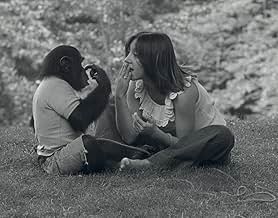Ajouter une intrigue dans votre langueTells the story of a chimpanzee taken from its mother at birth and raised like a human child by a family in a brownstone on the upper West Side in the 1970s.Tells the story of a chimpanzee taken from its mother at birth and raised like a human child by a family in a brownstone on the upper West Side in the 1970s.Tells the story of a chimpanzee taken from its mother at birth and raised like a human child by a family in a brownstone on the upper West Side in the 1970s.
- Réalisation
- Scénario
- Casting principal
- Nomination aux 1 BAFTA Award
- 16 victoires et 30 nominations au total
- Self
- (images d'archives)
- Self
- (images d'archives)
- Self
- (as Dr. James Mahoney)
- Self
- (images d'archives)
Avis à la une
What instead results is indeed a spectacle to witness. Nim is indeed a remarkable chimp who was sadly the victim of human inexperience with supplying the type of care he needed and deserved. What we learn is not what a chimpanzee is lacking, but what humanity is.
I suggest watching the film with a mind towards what Nim himself must be thinking as you see his life unfold. Nim lives a chimpanzee's analog to a human life, but for a chimp, it is utterly horrifying to watch. But like any life, there are more lighthearted moments as well, such as Nim and his friend Bob with their "Stone." "Smoke." "Now." time together, which actually seemed to be Nim's best time with any humans.
All in all, this documentary of Nim's life serves as a reminder that mother nature made chimpanzees and humans their own devices for communicating and living separately. The two cannot co-exist peacefully within one habitat due to the gap in strength and cognitive intelligence. However this one chimp, Nim, came remarkably close to peaceful co-habitation and viable communication with humans and his cost for such was great.
There is a huge amount going on in this documentary as the carers over the years are interviewed with footage from the time. What emerges will probably anger and sadden most viewers. Though I felt that Nim's carers genuinely bonded with him what emerges is a largely a tale of careless cruelty.
Equally interesting and perhaps the root cause of what happens later is the relationships between the humans. Particularly between the project leader Professor Herbert Terrance and the numerous attractive research assistants. There are several references to the power he held and exercised. Overall it has to be said he does not emerge from this film as either likable or particularly competent.
The various approaches of the teachers and carers differ so widely and even though there is much happy footage you have to wonder at the effect this had on Nim. I was left with the feeling that he eventually responded best to the people who recognised him as a chimp but still treated him as a companion within the limits this imposed.
This is a powerful film that should be shown as widely as possible and would probably be good thing to included in school curricular.
Firstly, I do agree with the other reviewers comments on futility, I do not, however, agree entirely with Professor Terrace's view that the project was a failure, though conversely I do think the project failed Nim. To expand on this I would say that the conclusion of Terrace's failure seemed to fit a classic narrow set of parameters by which you compare and judge the outcome solely on an initial and highly specific expectation of what you will achieve. To this end perhaps it failed Professor Terrace's criteria.
I think however opportunities were certainly lost. Nim seemed to interact in so many subtle and fascinating ways during the process of his teaching, and he seemed to teach a great deal to all of the assistants who gave him their care. There seemed to be so little structure from the start with regards to what was to be taught and observed and in which direction the project should be going.
The only constant seemed to be the teaching of signing, at which Nim excelled! From what I could see, regardless of whether he learnt the actions to manipulate his handlers or not, he still learnt the signs. Since it was known that the chimp could not form human speech, how was it to communicate what it had learnt and why it was using the language in this way? I found this point frustrating and dubious and an example of one person with their eye so "firmly on the prize", that they miss the importance of the process.
Importantly, everybody who was involved across the duration of the project was given a chance to clearly state the turn of events. Perspectives on this varied widely, as you would expect, as everybody brought a different set of expectations and sensibilities, but it was a mature approach which I think led to the films balanced handling of Nim's story.
All in all I found it a fascinating cautionary tale. Luckily the balance of academic ego versus humanity that twists through this story left me with hope that indeed something had been learnt from the unique life of this Chimpanzee.
The movie is more about a team of people trying to salvage and place an off the track train back on it, when the damage was already done.
Le saviez-vous
- AnecdotesVeteran primate choreographer and actor Peter Elliott actually met and worked with Nim Chimpsky when he was researching chimpanzees for Greystoke, la légende de Tarzan (1984). He also met and worked with another famous signing chimp by the name of Washoe.
- Citations
Herbert Terrace: Wouldn't it be exciting to communicate with a chimp and find out what it was thinking? If they could be taught to articulate what they were thinking about, this would be an incredible expansion of human communication, and possibly give us some insight into how language, in fact, did evolve.
- ConnexionsFeatured in Maltin on Movies: Harry Potter and the Deathly Hallows: Part 2 (2011)
- Bandes originalesCollide
Written by Autumn Rowe
Meilleurs choix
- How long is Project Nim?Alimenté par Alexa
Détails
Box-office
- Montant brut aux États-Unis et au Canada
- 411 184 $US
- Week-end de sortie aux États-Unis et au Canada
- 25 820 $US
- 10 juil. 2011
- Montant brut mondial
- 612 839 $US
- Durée1 heure 33 minutes
- Couleur
- Mixage
Contribuer à cette page




























